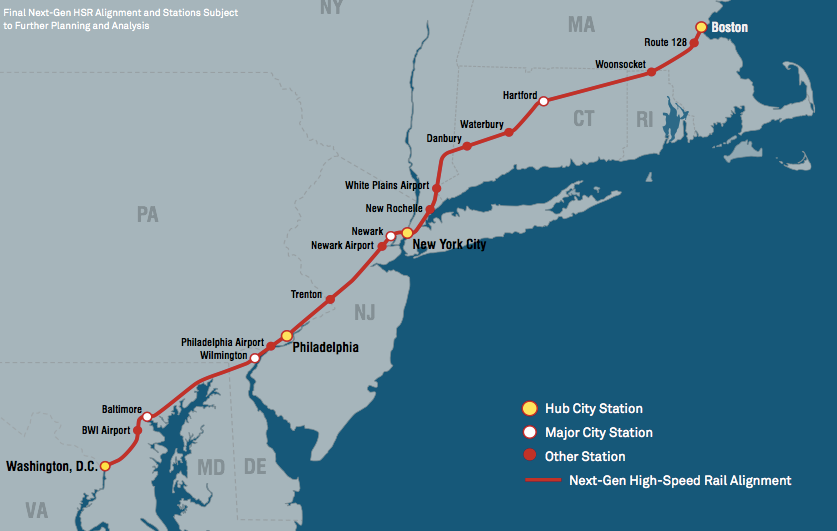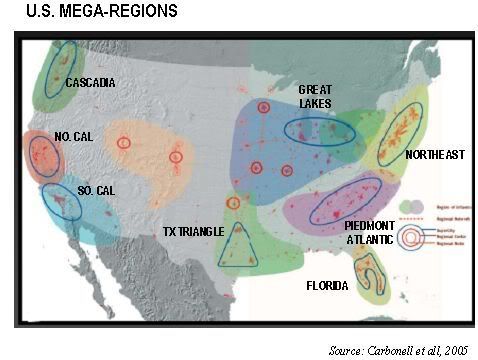 For the Daily Kos edition of this essay, I wrote:
For the Daily Kos edition of this essay, I wrote: This is a fairly short Sunday Train, but I thought I better get something posted, so I had somewhere to put this scheduling announcement:... but, hell, given the haphazard scheduling of the crossposts (eg, posting on Sunday and crossposting on Wednesday evening), y'all likely won't notice the change.
- Due to a new prep on Monday Morning this coming Fall term, the Sunday Train is temporarily moving to Tuesday Evenings until the end of year Holidays, starting next week (19 October)
The actual Sunday Train portion is about one element of the Amtrak proposal for a High Speed Rail corridor for the Northeast: the alignment. At the preliminary proposal stage, an alignment must be selected for study so that preliminary cost and patronage estimates can be performed. However, if the decision is made to go ahead, a range of alignments will be (and, indeed, must be) studied.
So tonight I take a brief look at the alignment options from the report.
______________________________

Amtrak in the NEC: The Next Generation
 For those who missed last week's Sunday Train, the "Next Generation" proposal aims to build on the NEC Master Plan to provide Express High Speed Rail service in the Northeastern region, from DC to Boston via NYC.
For those who missed last week's Sunday Train, the "Next Generation" proposal aims to build on the NEC Master Plan to provide Express High Speed Rail service in the Northeastern region, from DC to Boston via NYC.The Master Plan aims to bring travel times on the highest speed Acela services down by a noticeable amount, but the main priority is on increasing service reliability. The NG-HSR plan aims to bring:
- NYC/DC times down from 2:42 to 1:55 on the Express and 1:36 on the Flyer;
- NYC/Boston times down from 3:31 to 1:46 on the Express and 1:23 on the Flyer; and
- DC/Boston times down from 6:33 on the Acela to 4:06 on the Express and 3:23 on the Flyer.
The Northern Alignments
 In the Northern alignments, there are three strategies for getting out of New York City:
In the Northern alignments, there are three strategies for getting out of New York City: - the Long Island alignments, which then tunnel across and arrive in Connecticut running toward the north by northeast;
- the New Rochelle alignment, which runs alongside the existing NEC through to New Rochelle, and then either runs along existing NEC shore or along the Air Line (with the modifications required by Express HSR, of course); and
- Up the Hudson River valley toward Poughkeepsie (forcing me to finally learn to spell Poughkeepsie, Tough Keep Sie except with a P)
There are two basic ways to get into Boston:
- along the existing NEC, either from Providence or joining the NEC near the boarder at Route 128
- in from Worcester toward the west by southwest.
And then, depending on the alignment out of New York, there is a wide range of rail and highway alignments to get through Connecticut.
One option that is not in the scope of the preliminary planning is more than one alignment: that is to say, one Regional HSR corridor, similar to the NEC, and focusing on the additional populations connected with Boston on one side and New York City on the other, and one Express HSR corridor, focusing on connecting metro Boston and metro New York.
The Southern Alignments
 There are a similar set of southern alignments, but I expect that the alignments to the east of the NEC can be set aside, which leaves the main contenders as being the "Allegheny" alignment and paralleling the existing NEC. Note that for the Allegheny alignment, the Emerging HSR Philadelphia/Harrisburg or "Keystone" corridor takes on added significance, since a Semi-Express could run NYC/Philalphia and then onto the Alleghany Express HSR via the Keystone corridor.
There are a similar set of southern alignments, but I expect that the alignments to the east of the NEC can be set aside, which leaves the main contenders as being the "Allegheny" alignment and paralleling the existing NEC. Note that for the Allegheny alignment, the Emerging HSR Philadelphia/Harrisburg or "Keystone" corridor takes on added significance, since a Semi-Express could run NYC/Philalphia and then onto the Alleghany Express HSR via the Keystone corridor. Further, the Keystone corridor could be used to connect the (informal) Appalachian Hub to NYC. Long time readers will recall that one backbone of the Appalachian Hub is a Steel Interstate on the Shenandoah Valley & Tennessee corridor. From the northern end of this backbone at Harrisburg, a service could continue down the Keystone corridor to the Alleghany NG-HSR corridor at Westchester PA (see map) and then on to NYC.
Further, the Keystone corridor could be used to connect the (informal) Appalachian Hub to NYC. Long time readers will recall that one backbone of the Appalachian Hub is a Steel Interstate on the Shenandoah Valley & Tennessee corridor. From the northern end of this backbone at Harrisburg, a service could continue down the Keystone corridor to the Alleghany NG-HSR corridor at Westchester PA (see map) and then on to NYC.Alignments and Connecting to the Rest of the Country
 As already suggested above, the choice of alignment in the Northeast can affect how easy it is to integrate into the Express HSR corridors from outside of the Northeast. And the map of potential emerging Mega-Regions in the United States gives one indication why that is important: the Great Lakes / Midwestern Mega-Region and the Piedmont-Atlantic Mega-Region are immediate neighbors to the Northeast, and at distances where Express HSR is a viable competing transport option under current energy prices ~ and where even 110mph Emerging HSR will be a viable competing transport option at the energy prices that we may well see in the decade ahead.
As already suggested above, the choice of alignment in the Northeast can affect how easy it is to integrate into the Express HSR corridors from outside of the Northeast. And the map of potential emerging Mega-Regions in the United States gives one indication why that is important: the Great Lakes / Midwestern Mega-Region and the Piedmont-Atlantic Mega-Region are immediate neighbors to the Northeast, and at distances where Express HSR is a viable competing transport option under current energy prices ~ and where even 110mph Emerging HSR will be a viable competing transport option at the energy prices that we may well see in the decade ahead.In my view, the westernmost alignments give the best connections. For New York and Massachusetts, the Hudson to Massachussets Highway alignment provide excellent benefits. For Pennsylvania, there are pluses and minuses to the Allegheny alignment ~ a major plus being the opportunity to split a train from Pittsburgh at Harrisburg, with one service heading to Philadelphia and south to DC and the other service heading express to NYC and beyond.
And of course, the western NY/MA alignment provides a substantial headstart both on an Express HSR corridor from NYC to Montreal via Albany and a Regional HSR corridor from Boston to Albany and the upstate New York region of Syracuse / Rochester / Buffalo.
However, for Connecticut, the westernmost alignment mostly bypasses the places they would most want to connect, and so if the western alignment is adopted for the Northern segment, we would want to be serious about pursuing a Regional HSR connecting the center of the state to both NYC and Boston.
The trick will be working out a system for funding. The 10 cents per gallon tariff on imported crude oil that I have previously suggested, with 1/4 of the proceeds to go to HSR funding, would only be a start toward funding any substantial number of miles of Express HSR corridor. However, if focused on 110mph Emerging HSR and 125mph Regional HSR, it seems like it could certainly support a 110mph or 125mph alignment to extend the Northeastern intercity route matrix.
Midnight Oil ~ King of the Mountain


2 comments:
I think the biggest need is simply for more trains. The Northeast Corridor is overcrowded, and needs to run more often.
Also, as someone who has had family living near the present tracks since they were built, Connecticut needs more than one rail line if trains are going to transport a significant number of people.
There is a limit on the number of trains on the NEC through Connecticut, because of the moving bridges on the shoreline route to let marine traffic through.
So yeah, a 125mph Regional HSR corridor through New Haven, independent of the NYC/New Rochelle speed bottleneck, would be a useful thing in its own right, independent of the Express HSR. It could run from New Haven to Providence (there is a rail corridor that is not included in the rail alignment map as it was not considered for a 220mph Express HSR corridor in the preliminary NextGen plan).
Post a Comment